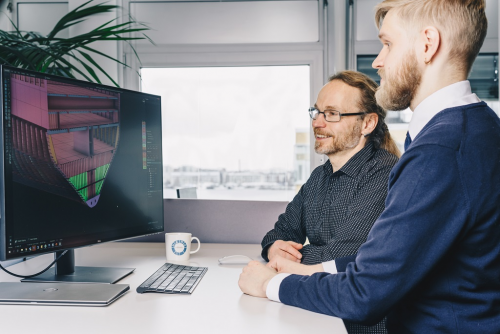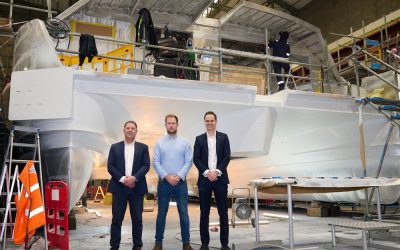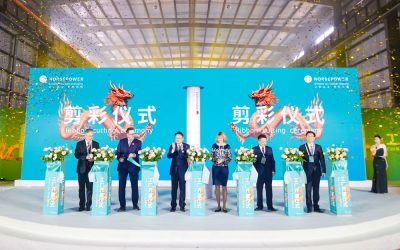The process of designing a ship has always been guided by an ambition to deliver cost-effective, safe vessels that will be adapted to the routes and purposes they serve. In recent years, an additional consideration has come to the forefront: sustainability. Tighter environmental regulation, higher fuel prices and growing pressure from customers and investors have all converged to increase the industry’s appetite for cost-effective designs that cut fuel consumption and reduce greenhouse gas emissions.
As shipping’s decarbonisation journey begins, shipowners want to ‘future-proof’ their fleets, and ensure their upcoming additions will meet environmental regulations, such as CII requirements, now and for decades to come.
This is a pivotal moment for shipyards. Not only have the goalposts shifted, with an unprecedented focus on sustainability, but the tools at their disposal have also evolved dramatically. Thanks to increased digitalisation, there is now a wealth of operational data that can be fed back to shipyards, and they must seize this opportunity to optimise their designs and create the sustainable ships of tomorrow.
Turning operational data into more efficient designs
The day a vessel leaves a shipyard used to be the end of the story. Once the ship was delivered, naval architects and engineers would move on to the next project, and very little information on their design’s performance would be fed back to the shipyard. This is changing rapidly, as we get to understand how real-life operational data can provide vital insights to create more efficient designs.
Real-life voyage data links theory and practice, providing shipyards with the unparalleled ability to analyse their vessels once they have been deployed at sea. Data on fuel consumption, GHG emissions, and speed profiles, for example, help understand how models behave in real-life conditions. For naval engineers, this is a formidable opportunity to iterate and improve their concepts to increase the efficiency of the future fleet.
Crucially, operational data can now provide granular insights into how to optimise each new design. For example, historical data from thousands of real-life voyages at sea can be analysed to give a statistical picture of the weather conditions that a ship is likely to encounter on specific routes. Based on that, naval architects and engineers can determine the level of engine power that will be needed for any given vessel depending on the routes where it will be deployed. This makes a valuable difference, enabling ship designers to make smart decisions and choose engines that will be sufficient to meet operational needs, while avoiding installing a more powerful engine that would increase emissions unnecessarily.
In the future, these calculations will be able to integrate even more data on the performance of various clean technologies, such as batteries and wind propulsion solutions, as more of these systems are deployed in real-life conditions at sea. This will add certainty to the critical choices that must be made about what technologies will be installed on board, with a fact-based picture of their effectiveness and return on investment (ROI). Having access to the best possible information will enable shipyards to fully account for the contribution of these systems in their calculations, and level up sustainability and efficiency even more.
The same data can also be used to better understand how newbuilds will comply with CII requirements, from their entry into service to their retirement, and predict when the vessel’s CII rating will fall to an unfavourable class. This gives owners and operators the long-term visibility they need to make the best possible choices from the initial design stage.
Unlocking data-driven efficiencies at sea
The “data bridge” that is emerging between ship operations and design goes both ways: while operational data is used to create more efficient ship designs, the digital models used to design the ships can also be harnessed to optimise operations at sea.
The 3D models used to design a ship constitute its “digital DNA”, containing a wealth of information on its unique characteristics and systems on board. In other words, a vessel isn’t just the steel-made physical structure; its Digital Twin is equally important, helping understand and predict its behavior in various conditions.
These vessel-specific insights can take voyage optimiation to the next level. By using the ship’s Digital Twin, we can model and simulate hundreds of possible routes and their impact on ETAs, fuel consumption and emissions. From this, we can calculate optimal routes and speed profiles depending on weather conditions as well as the ship’s specific profile, design, and operational needs. This gives captains and operators better visibility on all possible options, which enables them to choose optimal routes to minimise their impact on the environment without compromising operational efficiency. For example, our NAPA Voyage Optimization solution cuts fuel consumption and emissions by an average of 5-15%. This is a key example of how data continues to support sustainability throughout a vessel’s lifecycle.
Incorporating clean tech
The capacity to optimise operations for each vessel will be even more important in years to come, as ships are becoming even more complex. No two ships are the same, and this will be even more true in the future, as alternative fuels and a broader range of clean technologies are deployed. Using ship-specific digital models will help vessels make the most of innovative clean technology on board, such as wind propulsion solutions.
Advanced weather routing is essential for all ships, but it is particularly important for wind-assisted vessels, helping them catch optimal wind conditions to deploy their sails or wings. Recognising that the combination of voyage optimisation and wind propulsion provides significant potential for increased performance compared to either of the two technologies alone, we recently announced a partnership with wind propulsion leader Norsepower to help owners maximise the benefits of their Rotor Sails technology by using our Voyage Optimization software.
As shipping incorporates new fuels, wind power, batteries, automation and other new efficiency technologies, having a clear picture of the vessel’s technologies and set-up will be essential for efficient operations – helping operational teams understand the specificities of their vessel, make sense of all the systems on board and use them in the best possible way to optimise operations and reduce emissions.
Sustainability and safety go hand in hand
The current digital era will not only make ships more efficient, but also safer. Data-powered insights enable ship owners and operators to take a proactive approach to safety, where safety risks are monitored and assessed constantly, and can be addressed before they escalate.
This approach combines operational data with advanced stability models, often based on the same models that were used to design the ships. A range of variables that may affect a vessel’s stability, from deadweight changes to weather conditions, to the number of doors left open on the ship, are monitored constantly. This operational data is fed into a cloud-based system continuously, where a wide range of calculations related to hydrostatics, intact stability, damage stability and longitudinal strength can be made in real time.
This creates a continuous risk assessment that can be monitored by crew and shoreside teams alike, and where any issues can be flagged before they ever become a serious problem. This shared situational awareness between ship officers and shoreside teams is also key to a swift and efficient intervention in case of an emergency.
The collaboration challenge
Data is building new bridges between design and operations, however, for these bridges to achieve their full potential they need to be supported by greater cooperation on information sharing. The more high-quality data we have from real-life operations at sea, the more we will be able to accelerate the development of designs and operational patterns that will meet the planet’s (and the industry’s) needs for greater sustainability.
Improving the sustainability of shipping requires a partnership that ranges from shipyards to class societies, to shipowners, operators, charterers, cargo owners and more; and by bringing this data together, NAPA provides the tools for all stakeholders to innovate and collaborate, now and in the future.
The sustainable ships of the future will be made of data just as much as steel – created from real-life insights, and assembled by a collaborative spirit.
Olli Puustinen is director of product management at NAPA Design Solutions.







